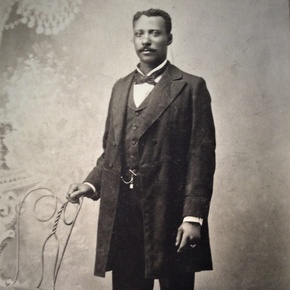
Early Homesteaders and Settlers
Silas William Black
Life in Saskatchewan
Silas came to Ogema, Saskatchewan in April of 1911 where he purchased land and began his farming life. Silas was laid to rest in Bengough Cemetery in Saskatchewan in April of 1943
Ancestry
Born in January 1853 south of the Mason-Dixon Line, USA
Contributions
Farming
Silas William Black was a father, husband, and settler. He was born into slavery south of the Mason-Dixon Line on a frigid day in January around 1853.
As the years of tribulation passed by and freedom rang in the USA with the abolition of slavery, a free Silas, alongside his Kentucky-born mother set out on foot taking a challenging journey to the north. As the years in Missouri passed by, his mother’s ever-growing family relocated to Illinois where most of them settled permanently.
Later Silas made his way to Minnesota where he met a young Norwegian woman named Martha Ellingson. Their soon-to-be union charged and challenged by the court, ultimately succeeded in favor of the young couple. They became wed at once before the judge. Shortly after, they lost an infant son Chas and later premature twins.
With his optimism rising, Silas made his way to Cooperstown, North Dakota to settle and sent for Martha soon after. It was there that Silas started using his skill of barbering to offer his services in the local community, eventually opening his very own successful barbershop on Main Street, which resulted in a career of over 25 years. All the while, he and Martha went on to have eleven children together, Norah, Iola, Anna, Ella, Emma, Francis, Myrtle, Oscar, Edna, Harold and Adolph.
Around the age of 58, Silas heard of the ‘free’ land opportunity Canada West had to offer. This was advertised through the local papers, posters around town, and talked about in his shop frequently. This attracted Silas to the notion as he prepared for this future prospect, and in his readiness left Cooperstown on April 26, 1911, making his way up to Ogema, Saskatchewan. All the while, Martha and the family anxiously waited back in North Dakota for the right time to join once he was situated. On May 9, 1911, he had made his way to the Dominion Lands Office. Where he submitted his homestead application with the $10.00 registration fee for his right of entry for a quarter section (160 acres) in Key West Rural Municipality. With that step complete Silas’ Canadian journey had officially begun.
As Silas’ hopes for the future commenced, he was met with lengthy, heavy, and exhausting days of clearing the fields of rocks, boulders and debris that lay across his wide-open prairie land. From then on came the labour-intensive breaking of the land for the growing of the hay. Done by his team of oxen’s and him behind the plow. He often did this for others and sometimes for exchange of dry goods from the owner of the General Store in Glasnevin. In the good haying years, the extra hay was hauled into the local towns and sold to Bengough and Ogema livery, feed and sale stables.
After 3 years of rigorous work on and around the homestead Silas had successfully fulfilled the Crown’s required duties for the land. On October 19, 1914, he was granted Homestead SE Section 5 in Township 7 Range 23 West of the 2nd and a Pre-emption quarter section on SW Section 5 in Township 7 Range 23 West of the 2nd. His farm was close to three and a half miles south of a hamlet named Glasnevin. Making him the first black Canadian pioneer in that district. While here, Silas had many obstacles and challenges to get through and overcome in the face of adversity that would have deterred so many other people
With a recent addition to his home that made enough room, Martha, with some of the children, made their way up to the homestead in autumn of 1914. This offered more relief in everyday chores around the farm. Throughout the next following years, a few more children followed his lead. During the summers and on occasions, the remaining ones living in the USA would come up to visit.
Silas was an extremely active and fit man, always on the go often picking up odd jobs to supplement the farm income. Praised as an industrious worker, he helped build a grain elevator in addition to being hired on by local farmers around Glasnevin to work on their threshing crews. He worked on the local railroad and would continue to put his barbering skills to good use by offering his services to the coal miners and others.
His Wife, Martha, battled cancer for 2 years and would often travel back into the states for treatments. She succumbed from the disease while in Cooperstown in 1919 and there she was laid to rest. Silas continued to raise up his children who went on to be successful schoolteachers, farmers, musicians, carpenters and other respectable careers. All while creating families of their own.
On March 7, 1927, Silas sold the farm to his son Harold where he farmed for many years with his own family. From thereon Silas moved into the town of Bengough to his daughter Francis’ house, who he lived with for numerous years. In his final years and failing in vision, Silas then stayed with and was cared for by his daughters Anna, Ella, and Edna in their homes.
Silas quietly passed away at his daughter Ella’s farmhouse in April of 1943, at the well lived age of 90. Silas was laid to rest in Bengough Cemetery in Saskatchewan. Silas, following his adventurous spirit in life, lead him on this incredible journey with his family. Silas helped lay down the foundation for those who farm there today.
